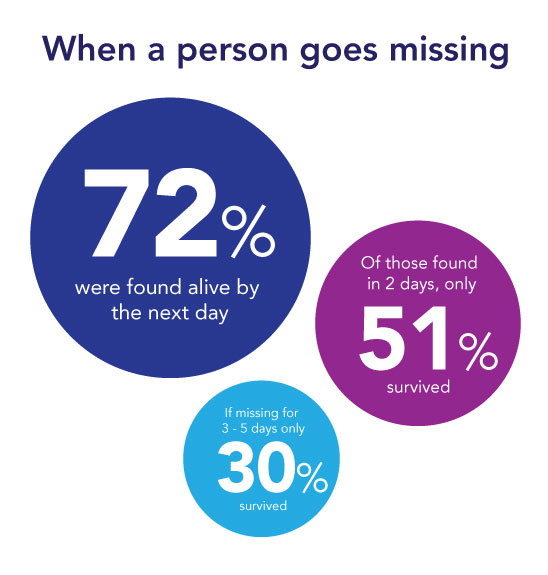
Feb 11, 2020
Research shows dementia wandering is more lethal than we thought
The Alzheimer’s Association states that 60% of persons with dementia (PWD) or Alzheimer’s will wander during the course of the disease. Wandering can take two forms: walking in patterns which is typically not harmful; and wandering that leads to a person going missing. While many of those afflicted with Alzheimer’s and dementia are returned safely to their care settings, when it does go wrong it can go very, very wrong. A research study looked at the outcomes of missing incidents for persons with dementia, where a search effort was required to find them. The information was more tragic than I thought.
According to the research:
- 74% of persons with Alzheimer’s and dementia wandered from home: walking, bicycling, driving or public transportation
- 30% of missing incidents perished: by exposure, drowning, injuries or fatalities from car accidents
- If they were found alive, 72% were found by the next day. Of those found in 2 days, only 51% survived. If missing for 3 – 5 days only 20% survived. One out of 14 don’t make it home alive.
- A better chance of survival/being found in urban environments because of a higher probability of a “good samaritan” stepping in
- There was no forewarning, missing incidents happen during previously normal, non-wandering activities
- Most persons with Alzheimer’s or dementia didn’t wander far, but will conceal themselves for protection, making them more difficult to locate
- Wandering events are unpredictable, so unless one has superhuman powers there is very little a caregiver can do to prevent it.
Why do people go missing?
One of the most interesting parts of the study was why people went missing – there was no clear reason. Most of the persons with Alzheimer’s and dementia who went missing were “…conducting a normal and permitted activity in the community [or there was] a lapse in supervision with the expectation that the PWD would remain in a safe location but did not.” They would go missing during normal activities they had successfully done before like going for a walk, a drive, or being out with their caregiver.
Other times people would go missing when “…they were left alone in a familiar location temporarily during a usual activity, such as when left watching television while the caregiver was elsewhere in the home or when allowed to rest in a store or parked car while the caregiver shopped.” At Theora Care we have often seen this with our customers – Marie turned around and her husband was gone while grocery shopping, an activity they had done thousands of times before, their story here. Jeff’s wife Judy got lost on one of her regular walks that she had taken many, many times before without incident, a short video of their story here.
Wandering is unpredictable
While the missing incidents always happened when persons were unsupervised, most of the time the lack of supervision was based on previous successful outcomes of similar activities. These were activities that were normal and had been done safely many, many times before. There was never a forewarning or indication for the caregiver in the missing incidents that this time, the care recipient would bolt. The only common thread was the unpredictability and unexpectedness – there were few predictors that the person with Alzheimer’s or dementia would leave and require help, and sadly dementia wandering devices were not available yet. This is especially concerning when the protocol for early stages of Alzheimer’s and dementia is to keep the person out and about and active, participating in their normal activities to keep their mental and physical health up.

Where did they go? And how did they get there?
Most people didn’t go far and were found within 1-5 miles if walking, or less than 50 miles away if driving. The most common wandering mode was walking, followed by driving and public transportation. 50% of the walking wanderers who perished were found very close to where they were last seen. And these wandering incidents were not driven by the person wanting to go home, to work, or a familiar place. These incidents happened because the person with Alzheimer’s or dementia became spatially disoriented, which can happen at any time. And again, no technology could provide wandering alarms for dementia.
Why did 30% die?
Even if the persons didn’t go far, they were hard to find. Often, they hid to protect themselves from the elements or to feel more secure. According to the study, exposure was the most common form of death, followed by drowning and accidents (e.g. car). When hiding, they did not often respond to searchers or their name being called. Many times searchers were right next to where they were concealed but still didn’t find them in time. Most of the deaths happened in non-urban areas. And, the longer it takes to find them, the worse their chances are for survival.
Why did the rest live?
Basically, because they wandered in an urban environment. Tracking devices for Alzheimer’s and for adults with dementia were not used to locate wanderers, so it came down to luck and good Samaritans. You encounter more good Samaritans in a populated place than in a less populated setting. Many times it was a stranger who noticed there was something off about the person and intervened to get help. This significantly shortened the time it took to find them, and improved survival rates.
If I can’t predict it and can’t prevent it, what can I do?
This research struck home with me. My mother had dementia, and we followed the “keep her out and active” protocol to maximize her health. My mother was very independent in the early stages, driving herself to racquetball, stores, appointments, and social activities. Even when the family and professional caregivers became more involved and she was supervised, this research shows that’s not enough. I had no idea how close we were to disaster — our family was just one of the lucky 40% minority who didn’t have a wanderer.
Faced with the same situation and this knowledge today, the one thing I would add to her caregiving mix is technology. As busy caregivers you can’t be there all the time, and you can’t rely on strangers to help, or that she will conveniently go wandering in an urban environment where she’s more likely to be found. You also cannot rely on her speaking up when she needs help. Having an Alzheimer’s GPS tracker watch for dementia and elderly care would help me to know where she is so she can be recovered in 24 hours, not days. A tracking wearable with 2-way hands-free voice communication would let me speak to her directly and reassure her that help is on the way. It would also let me speak with any good Samaritans who might be trying to help her, like when our customer Marie called her husband on his wearable and spoke with the good Samaritan standing next to him. I would also add in a wandering alert beacon that works with the wearable. That way, her caregivers would be alerted if she left the home, or if she was more than 75 feet away if they were out and about.
Basically, I would do what one of my favorite families does in taking care of their mom. You can see how they have minimized the risk of losing her using technology in this video. I wish I had the knowledge and technology back then so that I could have taken as good care of my mother as Elba’s children take care of her.
Written by Shel Symonds

